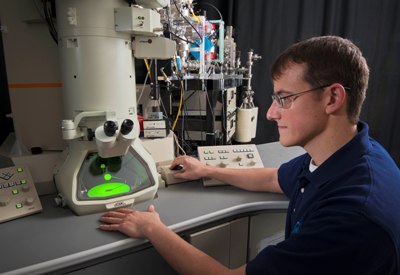Using Ion Beam Laboratory (IBL), Researchers from Sandia National Laboratories are performing a study to assess the development of advanced materials to enhance the existing reactors and to construct new nuclear reactors.
 Materials scientist Khalid Hattar sits in front of the in situ ion irradiation TEM. The green light is electrons hitting phosphor. (Photo by Randy Montoya)
Materials scientist Khalid Hattar sits in front of the in situ ion irradiation TEM. The green light is electrons hitting phosphor. (Photo by Randy Montoya)
The operators of the reactors require enhanced cladding materials or alloys to cover the nuclear fuel rods. Superior alloys will have less deterioration resulting from exposure to coolant fluids, radiation damage and others. The efficiency of reactors can be improved through better understanding of cladding alloy materials.
To achieve the goal, Khalid Hattar, a materials scientist, and his team are using IBL to attain a basic understanding of the nuclear materials at the nanoscale level. Researchers have developed a system to test the materials under extreme conditions. The system allows scientists to work at temperatures ranging up to 1,200°C and pressure of about 1 atm to better understand the radiation damage.
The Laboratory Directed Research & Development (LDRD) project, which has been recently completed, has worked on several samples of materials used in existing nuclear reactors. The project results revealed that a combinational method can be utilized with new alloys under perfect conditions. In an experiment, researchers have investigated the composition as well as the effects of radiation over an alloy that will be used in the new generation of reactors.
Hattar and his team have linked the transmission electron microscope (TEM) with the large tandem accelerator. The accelerator generates the radiation, which is transferred into the microscope. Through the microscope, researchers are able to observe the irradiation of materials. The IBL system has been recently added with the Colutron accelerator and this allows Hattar’s team to use the beam produced from the accelerator for future research work.